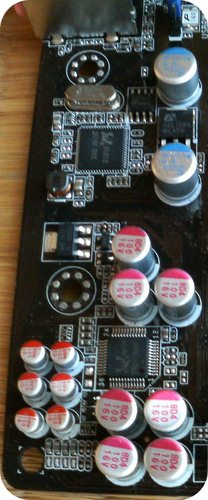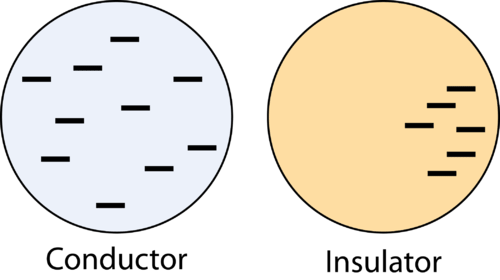电动器
章节大纲
-
The boards found in your computer, phone, calculator, and pretty much every other you own often look much like the one shown above. Many circuit boards have capacitors, including this one. Capacitors can be used to smooth out electrical impulses or to turn constant electric currents into a series of impulses. Use the simulation below to begin your exploration of capacitors and discover how capacitors are used in a camera’s flash:
::在你的计算机、电话、计算器和几乎你拥有的每块电板中发现的电板通常看起来都与上面显示的电容器非常相似。 许多电路板都有电容器,包括这个电容器。 电容器可以用来平滑电动脉冲或将恒定电流转化为一系列电脉冲。 使用下面的模拟开始你对电容器的探索,并发现电容器是如何在相机闪光下使用的:The Capacitor
::电动器Sharing Charge
::共享共享费用We already know that insulators are materials that do not allow electrons to flow through them easily. When you place excess electrons on an insulator , the electrons remain where you put them and do not move around. Conversely, conductors are materials that allow electrons to flow thorugh them freely. Since electrons repel each other, excess electrons on a conductor move to positions as far apart as possible. The difference can be seen in the image below, where the electrons on the insulator remain clumped near each other, while the electrons on the conductor have spread out to cover the whole surface.
::我们已经知道绝缘器是不允许电子轻易通过它们的材料。 当您将超量电子放入绝缘器时, 电子会留在您放入的绝缘器上, 而不会移动。 相反, 导电器是允许电子自由流动的材料。 由于电子相互反射, 导电器上的超量电子会移动到尽可能远的方位。 从下面的图像中可以看到这种差异, 隔热器上的电子会一直相互挤压, 而导电器上的电子会扩散到覆盖整个表面。Consider a charged conductor and an uncharged conductor. When the charged conductor is touched to the uncharged conductor, as far as the electrons are concerned, it has become one large piece of conducting material. The electrons on the charged object will run onto the uncharged object until the density of the charge is evenly distributed over the entire surface of both objects. If the objects are the same size, the charge will be shared equally throughout. This method is occasionally used to divide a charge by half.
::考虑一个充电导体和一个未充电导体。当充电导体被触碰到未充电导体时,就电子而言,它已成为一个巨大的操作材料。充电对象上的电子将运行到未充电对象上,直到充电密度平均分布在两个物体的整个表面。如果物体的大小相同,充电将全部平均共享。这种方法偶尔用来将充电量减半。The earth is also a conductor. Touching a charged object to the earth is called grounding . When you touch a conductor to the earth, you allow the earth to share the charge. Since the earth is billions of times bigger than the object, the earth takes nearly all of the charge. The charged object that was grounded now has zero charge.
::地球也是一个导体。 触碰地球的电荷物体叫作地面。 当你触碰地球的导体时, 你允许地球分享电荷。 由于地球比天体大数十亿倍, 地球几乎占了全部电荷。 被击落的电荷物体现在是零电荷。It is very easy to ground an object. All that is necessary is to touch a conducting wire to both the object and the earth. Electrical devices that run the risk of picking up a large static charge are grounded, meaning they are connected to the earth via such a conducting wire. Virtually all household appliances, especially washers and dryers, are grounded in this way to eliminate static charge. Similarly, large trucks, especially gasoline tankers, are grounded via a large chain hanging off the back to prevent sparks when fuel is being unloaded.
::将一个物体放置在地面上非常容易。 唯一必要的是触摸到该物体和地球的导电线。 可能接收大量静电电荷的电气装置被禁闭,这意味着它们通过这样的导电线与地球相连。 几乎所有家用电器,特别是洗衣机和烘干机,都以这种方式被禁闭,以消除静电。 同样,大型卡车,特别是油罐车,也通过一个大链条被禁闭在背后,以防止燃料卸下时的火花。Spheres, whether hollow or filled, will always have the excess charge on the surface. In hollow spheres, the only place for an electron to exist is on the surface. Similarly, in a solid conducting sphere all the excess charge sits on the surface. This conclusion is a result of Gauss’s Law , which tells us that the symmetry of the sphere and the fact that the electric field within the sphere is 0 forces the charge to the outside.
::球体,无论是空的还是填充的,都总是在表面有超载。 在空心球中,电子存在的唯一地方是表面。 同样,在坚固的操控球中,所有超载都位于表面。 这一结论是高斯法律的结果,它告诉我们球体的对称性以及球体内电场是0把电场推向外部的事实。Capacitors Store Charge
::电动电动电动器Pieter Van Musschenbroek, a Dutch physician, invented a device in 1746 that could store electric charge. Though he named the device a Leyden jar, similar devices today are called capacitors. A typical capacitor consists of a pair of parallel plates of area @$\begin{align*}A\end{align*}@$ separated by a small @$\begin{align*}d\end{align*}@$ . The space between the two plates is most often filled with an insulator and frequently the plates are rolled into the form of a cylinder.
::荷兰医生Pieter Van Mussschenbroek在1746年发明了一种装置,可以储存电费。虽然他把装置命名为Leyden罐,但今天类似的装置被称为电容器。典型的电容器由一对平行的区域板块组成:@$\ begin{align}A\end{align}{align}$分离成一个小的@$\begin{align}d\end\end{align}$。两个板块之间的空间通常装满一个绝缘器,通常将板块卷成一个圆筒。If is applied to a capacitor, it quickly becomes charged. One of the parallel plates acquires a negative charge and the other an equal amount of positive charge. For a given capacitor, the amount of charge, @$\begin{align*}Q\end{align*}@$ , acquired by each plate is proportional to the potential difference, @$\begin{align*}V\end{align*}@$ .
::如果对电容器施用,它会很快被电荷。一个平行的板块获得负电荷,另一个获得等量的正电荷。对于一个给定的电容器,每个板块获得的电荷量(@$\ begin{align{end{align}{align}}$)与潜在差数成比例,@$\ begin{align}V\end{align}{align}{align}$。@$$\begin{align*}Q=CV\end{align*}@$$
::@ $\ begin{ 调整} CV\ end{ 调整} $@$\begin{align*}Q\end{align*}@$ is the charge in coulombs, @$\begin{align*}V\end{align*}@$ is the voltage in volts, and @$\begin{align*}C\end{align*}@$ is the particular capacitor’s constant of proportionality. @$\begin{align*}C\end{align*}@$ is also called the capacitance of the capacitor. The capacitance is the voltage the capacitor can reach before it discharges, allowing the voltage across the capacitor to drop to zero and the current to cross the capacitor. The SI unit for capacitance, according to the equation above, will be coulombs/ volt , and this unit has been given the name farad (F). Most capacitors have capacitances in the range of one picofarad (10 -12 F) to one microfarad (10 -6 F).
::@ $\ begin{ align{ end{ align} $ 是 Coulombs 的电源, @ $\ begin{ align}} V\ end{ ALign}$ 是伏特的电压, 而@ $\ begin{ ALign}} C= ALign}$ 是特定电容器的相称性常数 。 @ $\ begin{ laign} { laign} 也被称为电容器的能力。 电容器在排放前能够达到的电压是电压, 允许电容器的电压下降到零, 电流穿过电容器。 根据上述方程式, SI 能力单位将是 coulombs/ volt , 这个单位被命名为远方( F ) 。 大多数电容器的电能在1 个( 10-12 F) 到 1个微法 ( 10-6 F) 的范围 。Example
::示例示例示例示例A sphere has a potential difference between it and the earth of 60.0 V when charged with 3.0×10 -6 C. What is the capacitance?
::一个球体与地球之间可能存在60.0V的差别,当它充电3.0x10-6C时。 电能是什么?@$\begin{align*}C=\frac{Q}{V}=\frac{3.0 \times 10^{-6} \text{ coulombs}}{60.0 \text{ volts}}=5.0 \times 10^{-8} \text{ farads}\end{align*}@$
::@ $\ begin{ align} C\\\ frac\\ V\\\ frac} 3. 0\ times 10\\ 6}\ text{ coulombs\\\ 60.0\ text{ vols\\ 5.0\ times 10\\\\\\\ 8}\ text{ falads\ end{ align$} @ text{ falads\ end{ leign$ </span> </p> <button class="play-button btn btn-success" style="float: right;" value="@s"> 播放段落 </button> <p id="x-ck12-OTVmM2M3Yjg3MjRjOGYwZDI3NTRkZWJiM2FlODVlMjQ.-j4n"> <span style="font-weight: 400;"> Have you ever used an electronic device that can be controlled by human touch? These types of touch screens are really amazing and utilize capacitance to work. When you place your finger on the screen, you disrupt the electric field patterns that exist in the device and cause changes to its capacitive system, which the computer understands. Launch the Touch Screen simulation below to play around and learn more: </span> <br/> <span style="color: green; "> ::您是否曾经使用过可以用人类触摸来控制的电子设备? 这些类型的触摸屏幕非常惊人,并且使用了工作能力。 当您将手指放在屏幕上时,您会破坏设备中存在的电场模式,并改变计算机所理解的电磁系统。 在下面启动触摸屏幕模拟,以玩耍和学习更多: </span> </p> <div class="x-ck12-video-object" id="x-ck12-cfw"> <div class="iframe-wrapper ck12-no-annotation"> <iframe data-artifactlang="en" frameborder="0" height="225" id="x-ck12-MTUwNDI4NTIwOTI1MA.." longdesc="Learn%20about%20how%20capacitances%20add%20in%20series%20and%20parallel%20by%20exploring%20the%20physics%20behind%20a%20touch-screen%20device." name="196641" src="https://flexbooks.ck12.org/flx/show/interactive/user%3Ack12science/http%3A//www.ck12.org/embed/%23module%3Dlauncher%26artifactID%3D1916712%26nochrome%3Dtrue%3Fhash%3D23f653b1d5fe3816ad2fbe4b89bc73ef" style="max-width: 100%;" title="video" width="620"> </iframe> </div> </div> <button class="play-button btn btn-success" style="float: right;" value="@s"> 播放段落 </button> <h3> Further Reading <br/> <span style="color: green; "> ::继续阅读 </span> </h3> <ul id="x-ck12-NGY5MWI0MmMzMjg2ZWI0NTk3NDU1NTYwYTJkYjhhOTQ.-u4e"> <button class="play-button btn btn-success" style="float: right;" value="@s"> 播放段落 </button> <li> Capacitor <br/> <span style="color: green; "> ::电动器 </span> </li> <li> </li> <li> </li> <li> </li> </ul> <button class="play-button btn btn-success" style="float: right;" value="@s"> 播放段落 </button> <h3> Summary <br/> <span style="color: green; "> ::摘要 </span> </h3> <ul id="x-ck12-NTMzZmNmZjliM2VkMzU1NTQxYjczMDUwODhiNWJmM2Y.-zv4"> <button class="play-button btn btn-success" style="float: right;" value="@s"> 播放段落 </button> <li> Since electrons repel each other, when excess electrons are placed on a conductor, they will move to positions as far away from each other as possible. <br/> <span style="color: green; "> ::由于电子相互反射,当超重电子被置于一个导体上时,它们将尽可能移动到距离对方最远的位置。 </span> </li> <button class="play-button btn btn-success" style="float: right;" value="@s"> 播放段落 </button> <li> When a charged conductor is touched to an uncharged conductor, the electrons will migrate until the density of the charge becomes evenly distributed over the entire surface. <br/> <span style="color: green; "> ::当充电导体触碰未充电导体时,电子将迁移,直到充电密度在整个表面均匀分布。 </span> </li> <button class="play-button btn btn-success" style="float: right;" value="@s"> 播放段落 </button> <li> Touching a charged object to the earth is called grounding. <br/> <span style="color: green; "> ::触碰地球的充电物体 被称为地基 </span> </li> <button class="play-button btn btn-success" style="float: right;" value="@s"> 播放段落 </button> <li> A charged conducting sphere will always have all the excess charge on its surface. <br/> <span style="color: green; "> ::充电操控场表面总是有超重充电 </span> </li> <button class="play-button btn btn-success" style="float: right;" value="@s"> 播放段落 </button> <li> A typical capacitor consists of a pair of parallel plates, separated by a small distance. <br/> <span style="color: green; "> ::典型电容器由一对平行板块组成,相距小。 </span> </li> <button class="play-button btn btn-success" style="float: right;" value="@s"> 播放段落 </button> <li> <span class="x-ck12-mathEditor" data-contenteditable="false" data-edithtml="" data-math-class="x-ck12-math" data-mathmethod="inline" data-tex="Q%20%3D%20CV"> @$\begin{align*}Q = CV\end{align*}@$ , where @$\begin{align*}Q\end{align*}@$ is the charge in coulombs, @$\begin{align*}V\end{align*}@$ is the voltage in volts, and @$\begin{align*}C\end{align*}@$ is the constant of proportionality, or capacitance.
::@$\ begin{ align} = CV\ end{ align} $, 其中@$\ begin{ align}} end{ align} $ 是 Coulombs 中的责任, @$\ begin{ align} V\ end{ align} $ 是伏特的电压, 而@$\ begin{ align} C\end{ align} $ 是相称性或能力的常数 。Review
::回顾-
The two plates of a capacitor hold +2.5×10
-3
C and -2.5×10
-3
C of charge when the potential difference is 950 V. What is the capacitance?
::电容器的两盘电容器的电荷 + 2.5×10-3 C 和 - 2.5×10-3 C 电荷,当潜在差值为 950 V 时。 电容器的容量是什么? -
The potential difference between two parallel wires in air is 120. V. They hold equal and opposite charges of 9.5×10
-11
C. What is the capacitance of the two wires?
::空气中两条平行电线之间的潜在区别是120 V。 它们拥有9.5×10-11 C等同和相反的电荷。 两条电线的能力是什么? -
How much charge flows from a 12.0 V battery when it is connected to a 9.00 microfarad capacitor?
::当一个12.0V电池连接到一个9.00微法拉德电容器时,该电池的充电量是多少?
Explore More
::探索更多Use this resource to answer the questions that follow.
::使用此资源回答下面的问题 。-
What do capacitors do?
::电容器是做什么的? -
What are the units of capacitance?
::能力单位是什么? -
What is the formula for capacitance?
::能力公式是什么?
-
The two plates of a capacitor hold +2.5×10
-3
C and -2.5×10
-3
C of charge when the potential difference is 950 V. What is the capacitance?


